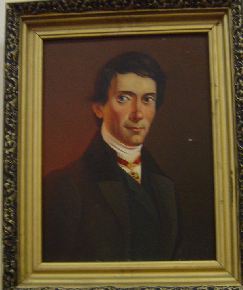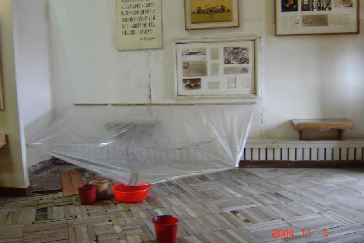
Gevorkian Seminary
(� R. Bedevian/Groong)
Armenian News Network / Groong
December 8, 2004
Travel Wire
By Ruth Bedevian
YEREVAN, ARMENIA
The rain was unrelenting the day my friend, Gohar, and I took a cab that took us from Republic Square to the highest part of Yerevan, well beyond the Cascade, to the birthplace and museum dedicated to Khachatur Abovyan. At the time that Abovyan was born, Kanaker was a small village on the outskirts of Yerevan. Today it is part of the city. There are several interpretations of the name's origin, one being that it was the name of one of Noah's sons and when the Ark landed and the waters ebbed, Noah's son settled here.

|
|
Young Abovyan at Gevorkian Seminary (� R. Bedevian/Groong) |
The Khachatur Abovyan Museum complex consists of the museum and the home in which Abovyan was born and where his parents lived. The birthplace was first established as a museum in 1939, utilizing valuable information from a book written by one of Abovyan's friends, an ethnographer, August Hagstauzen, entitled Transcaucasia; and in 1978 under Soviet rule a large edifice was constructed, designed by architect Liparit Sadoyan, which today contains an enormous exhibition hall, exhibiting Abovyan's literary, pedagogical, research and social work, including the first and subsequent publications of his writings, translations, and manuscripts. Paintings by Gevorg Bashinjaghyan, Ervand Kochar, Isabekyan, Hovhannes Zardaryan decorate the walls. Two images stand out in my memory: Abovyan dressed in the seminarian's costume as a young student at Gevorkyan seminary in Etchmiadzin (at the tender age of 9) and another of Abovyan with his students with Ararat as a backdrop.

|
|
Abovyan's mentor Dr. Friedrich Parrot (� R. Bedevian/Groong) |
Accompanied by three docents, Gohar and I first began touring the exhibition hall which covers the writer's family life, education, the Russian-Persian War of 1828 - 1830, Abovyan's friendship with Dr. Parrot and ascent of Mt Ararat, Dorpat University and his association with Estonia, his pedagogical activity and finally his writings, including, The Wounds of Armenia (Verk Hayastani).
The docents began to relate, `Abovyan was the first born son, arriving 6 years after the marriage of his parents, Avetik and Tackouhy. He had a brother named Garabed who died at 3 years old. As devout parents, they dedicated Khachatur to God and the young boy was enrolled in the Gevorkyan Seminary of Etchmiadzin. The Abovyan family had a great reputation for generosity which was primarily focused on Etchmiadzin. This generosity was a family tradition that was handed down from his grandfather...'
In 1822 Abovyan went to Tbilisi to continue his higher education at the Nersisian School being one of its earliest students. Displayed is a letter written by Catholicos Nerses Ashtaraketsi to one of the teachers of the Gevorkian Seminary, Anton Mughnesi, in which he describes Abovyan as a person of great talent.

|
|
Abovyan and Parrot Atop Mt. Ararat (� R. Bedevian/Groong) |
We came upon memorabilia that documents Abovyan's ascent to the top of Mount Ararat with Dr. Friedrich Parrot. Some of Abovyan's exercise books and a miniature globe that he made under professor Parrot's direction are displayed. Parrot was a professor of natural history and philosophy from Dorpat University (presently Tartu University in Tartu, Estonia). Abovyan, according to the docents' account, accompanied Parrot on this third attempt to scale the mountain, serving as translator for the Armenian local guides. This third attempt proved successful and on Sept 27 1829 they set foot upon the top of Mount Ararat and on October 27 - exactly a month later, they reached the top of Sis. According to Parrot's account, during this time, he was shown relics at St. Jacob Monastery at the Armenian Akori Gorge, located at an elevation of about 8000 feet. They were crosses which were said to have been made from Noah's Ark. Sadly, the monastery was violently shaken by an earthquake in 1840 and its relics were presumed to have been destroyed. Following this joint adventure, Parrot arranged for a Russian state scholarship for Abovyan to study at Dorpat. Upon his return from the university in 1837, Abovyan was appointed as supervisor of the Tbilisi district school, a position that he held until 1843.
While touring the exhibit, one cannot help but feel the closeness that Abovyan felt for Russia and the Russian influence upon his education, but at the same time one feels his abiding love for Armenia. In a display of Estonian artifacts given as a gift to the museum there is a title page and first page of the Sharagans (Armenian Hymns) that Abovyan presented to Tartu University library in 1831. Abovyan placed his hope in Russia, thinking that Russia would take Armenia under its wing and would encourage the revival of Armenian statehood. It was this deep love for his homeland that led him to feel betrayed when Russia abolished the Armenian Oblast (province) in 1840. Abovyan turned very hostile. One ruler, the Persian Empire, was replaced with another. [As history has shown since, Russian annexation proved the lesser of two evils in that, unlike the Armenians in the Ottoman Empire, the Eastern Armenians were not massacred.]

|
|
Give your life and soul but do not give your Motherland to the enemy (� R. Bedevian/Groong) |
Braving the rain, yet again, we stepped outside to tour the ancestral home. It is a charming introduction to a life lived 200 years ago and to appreciate the primitive beginnings of greatness - how from living off the land and being nurtured by spiritual parents who valued education - developed discipline, creating a patriot who did the best with his talents and made a difference in his lifetime as well as for posterity.

|
|
Poor Museum Conditions (� R. Bedevian/Groong) |
I was saddened to see several plastic drop cloths covering cherished items of irreplaceable value in the exhibition hall. The roof is leaking and the walls are cracked in several places due to dampness. The renovation of several museums by the Lincy Foundation - a magnanimous and visionary project - was concluded some time ago. The government of Armenia selected which museums Lincy should renovate and the Abovyan complex was not included, unfortunately. Each succeeding winter, it is feared, will do further damage. The Director, Mr. Hovhannes Zatikian, who is relatively new to his position (this is his second year) and a devotee of Abovyan, seeks help to improve the museum's restoration.
-- Ruth Bedevian continues her visits to Armenian authors' House Museums around Armenia. Her articles in this series are at: http://www.groong.org/orig/armeniahousemuseums.html � Copyright 2004, Armenian News Network / Groong All Rights Reserved.
|
Redistribution of Groong articles, such as this one, to any other
media, including but not limited to other mailing lists and Usenet
bulletin boards, is strictly prohibited without prior written
consent from Groong's Administrator. � Copyright 2004 Armenian News Network/Groong. All Rights Reserved. |
|---|